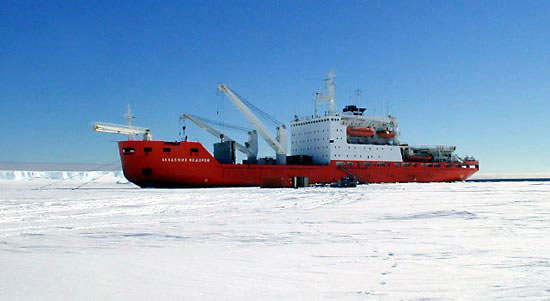
RUSSIAN FLAG STAKES ENERGY CLAIM AT NORTH POLE
Publication: Eurasia Daily Monitor Volume: 4 Issue: 153
By:

Russia made big international waves last week with a successful Arctic expedition that combined scientific and geopolitical goals. The research ship Akademik Fedorov and the nuclear icebreaker Arktika left Murmansk on July 24 and on August 2 reached their destination – the North Pole, now covered by only a thin layer of ice thanks to global warming. Two deep-water submersibles – Mir-1 and Mir-2 – reached the ocean floor at this special spot at the depth of about 4,300 meters and stayed there for about an hour, collecting samples and planting a Russian flag made from titanium, and then safely re-surfaced in the polynia near the mother ship. This was without doubt a remarkable achievement in the history of Arctic exploration, but its scientific value was compromised by the fact that the goal was not to examine the seabed, but to collect evidence for the Russian claim to a large part of underwater territory, which is political in nature and centered on securing the priority rights on developing natural resources, first of all hydrocarbons.
Mainstream Russian media had no doubt about the real aim of the expedition, featuring headlines like “The Battle for the Arctic” or “Russia Claims the Polar Seabed” (Rossiiskaya gazeta, August 3; Komsomolskaya pravda, August 1). Supporting evidence for the proposition that the fight for dividing the northern “frontier” has begun in earnest is found in Russian reports that a U.S. “spy” plane appeared once near the Russian convoy (Smart money, July 30). U.S. media, however, suggested that it was a Norwegian aircraft (Washington Post, July 27). Newspapers and TV channels in the United States and Canada duly covered the official responses to the Russian “victory,” but the wave of “patriotic” jubilation has only grown higher at home (Kommersant, August 4; Vremya novostei, August 3). For many Russians this flag-sinking (rather than raising) appears to be a somewhat belated compensation for the failure in the “race to the Moon” with the United States some 38 years ago, but a few significant features remain obscured in the lively debates.
First, the samples of yellowish dirt or sand collected at the top of the world cannot constitute any kind of proof that the Russian sea-shelf really does stretch all the way to the Pole (Moskovsky komsomolets, Lenta.ru, August 3). Back in 2001, Russia made an application to the UN Commission on the Limits of the Continental Shelf, but it was turned down due to the lack of scientific evidence. The Convention on the Law of the Sea (1982), which Russia ratified in 1997, defines clearly the 200-mile economic zone, but is rather vague about the exceptions, so it is nearly impossible to establish for fact that the Lomonosov and Mendeleev underwater ridges are a continuation of the Siberian continental platform.
Second, Russia has no technical capacity to explore the Arctic seabed much less develop its presumed riches. The celebrated pair of Mirs were built back in the mid-1980s in Finland based on a Soviet design and was rented out in the 1990s for all sorts of adventures, including an expedition to the Titanic, but they have not been modernized or followed by a new generation of submersibles. In fact, Russia has a drastic lack of capacity for most underwater operations, including search-and-rescue, as it was revealed exactly two years ago when a Russian mini-sub in distress near the shores of Kamchatka was miraculously saved by a British rescue team that managed to deploy its Scorpion unmanned vehicle across the whole length of Eurasia (see EDM, August 8, 2005). The Russian shipbuilding industry is in a protracted crisis, and efforts to organize a state-controlled holding company have not helped to revive it, as demonstrated by the failure to deliver on the contract to modernize the cruiser/aircraft carrier Admiral Gorshkov for India (Nezavisimaya gazeta, August 2).
The hidden feature that might prove to be the most significant in this context is Russia’s proven — but still astounding lack of interest in developing — natural resources. The super-monopoly Gazprom is the main culprit behind this phenomenon, and it has recently announced a reduction of its investment program for 2007-2008, first of all in the new projects such as the Shtokman gas field in the Barents Sea (Nezavisimaya gazeta, July 24). For years, Gazprom has prevented BP from developing the Kovykta field, and now that it has acquired control over this project it is not clear at all when the production might begin (Expert, July 2). In fact, the only example of successful development of new hydrocarbon reserves in the last 15 years is the group of projects in Sakhalin, but Gazprom, after wrestling its way into Sakhalin-2, is now blocking the plan for exporting natural gas to China from Sakhalin-1 (Vremya novostei, August 3).
With this in mind, the submerged Russian flag becomes not a claim for the right to prospect and mine mineral resources but rather a “no-go” sign that should stop others from doing it (Vedomosti, August 3). This strategy of conserving valuable “assets,” while failing to introduce even the basic measures in energy conservation, is not necessarily the result of strategic analysis but could spring from a mixture of political expediency and deeply felt dependency upon unsustainably high world prices on oil and metals. Seeking to maintain the breathtaking run-of-luck momentum, Russia has arrived in a rather tight corner where its fast growing internal demand for cheap energy clashes with the imperative to export huge volumes of hydrocarbons at the highest possible prices. Hence the current escalation of the oscillating “gas conflict” with Belarus, after which a new round of “gas war” with Ukraine would quite possibly follow (Kommersant, August 4). The symbol of Gazprom – a capital G with a blue flame – has become a sign of energy insecurity, and Russia’s attempts to maximize its benefits by stamping this symbol on every available reservoir, even deep under the Northern Pole, would inevitably backfire. False patriotism fuelled by gas intoxication is a recipe for a truly bad hangover.




